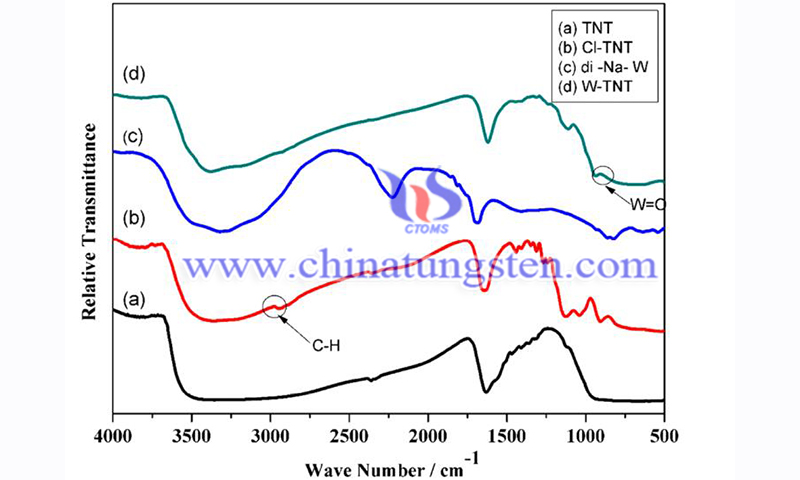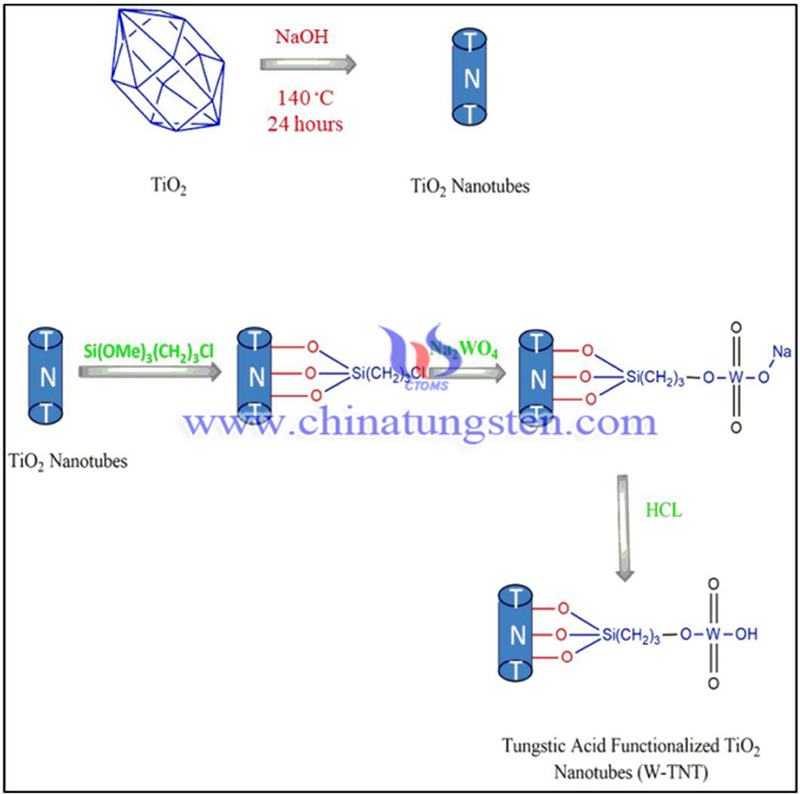Preparation of Tungstic Acid Functionalized Titanium Oxide Nanotubes
- Details
- Category: Tungsten Information
- Published on Friday, 21 October 2022 14:47
Titanium oxide nanotubes (TNT) were synthesized by hydrothermal method and covalently grafted with tungstic acid (ion exchange group) on their surface. The synthesized tungstate functionalized TNT (W-TNT) was characterized by SEM, TEM, and XRD analysis, and the successful grafting of the tungstate group was confirmed by FTIR and solid-state NMR techniques.
Composite membranes with different ratios of W-TNT (2%, 4%, 6%, and 8%) and sulfonated poly ether ketone (SPEEK) were fabricated in the study, resulting in high ion exchange performance. The prepared composite membranes were characterized by SEM, XRD, FTIR, water absorption, ion exchange capacity, and proton conductivity to ensure the suitability of the membranes for use as electrolytes in fuel cell applications.

From the study, it was found that SPEEK containing 6% W-TNT showed the best electrochemical performance. When this membrane was tested in a fuel cell as an electrolyte with carbon-supported platinum anode and cathode electrodes, a maximum power density of 352 mW cm-2 was achieved at 80°C. The presence of additional ion-exchange groups (tungstic acid) and the hollow nature of TNT resulted in better performance than normal membranes.
In recent years, there has been a growing interest in obtaining energy from renewable and eco-friendly sources, and as a result, fuel cells have become more popular because they generate energy from fuels and oxidizers with high efficiency and virtually no emissions.
Among the different types of fuel cells available, proton exchange membrane fuel cells (PEMFCs) are advantageous due to their unique characteristics such as low operating temperature, continuous operation at high current density, low weight, compactness, and high efficiency. Nafon (commercially available proton conductive membrane) is widely used in PEMFCs due to its high proton conductivity and good mechanical, chemical, and thermal stability.

However, its high cost, high fuel crossover behavior, and hydrocarbon backbone (non-eco-friendly) make it a serious drawback when used as an electrolyte for PEMFC. Therefore, researchers have been working on the development of cost-effective and eco-friendly polymeric membranes consisting of hydrocarbon backbones.
Highly engineered polymers such as poly ether ketone (PEEK), polystyrene-ethylene-butene-styrene (PSEBS), poly (ether sulfone) (PES), polyimide (PI), polyvinylimidazole (PVIM), polyphenylene (PPE), and polybenzimidazole (PBI) have been modified (sulfonated) to replace naphthofenes. Among these membranes, sulfonated polyether ether ketone (SPEEK) has been studied more extensively than others due to its good thermo-mechanical stability and decent electrical conductivity. However, these properties are not as good as Nafon. therefore, to improve the overall performance of SPEEK, nano-inorganic fillers such as TiO2, ZrO2 and SiO2, SnO2, WO3 have been incorporated into SPEEK membranes.
It is shown that the incorporation of nanoparticles increases hydrophilicity and provides a preferential pathway for the transfer of protons through water molecules (Grotthuss mechanism). In addition, the high specific surface area of the nanoparticles increases the interfacial interaction with the polymer, which increases the thermomechanical stability of the tungstate-functionalized titanium oxide nanotubes.
Cited paper: Elumalai V, Deenadhayalan T, Kathleen Asitha A, et al. Preparation of tungstic acid functionalized titanium oxide nanotubes and its effect on proton exchange membrane fuel cell[J]. SN Applied Sciences, 2019, 1(4): 1-12.
- Tungsten Manufacturer & Supplier, Chinatungsten Online: www.chinatungsten.com
- Tungsten News & Prices of China Tungsten Industry Association: www.ctia.com.cn
- Molybdenum News & Price: news.molybdenum.com.cn
- Tel.: 86 592 5129696; Fax: 86 592 5129797; Email: sales@chinatungsten.com



 sales@chinatungsten.com
sales@chinatungsten.com